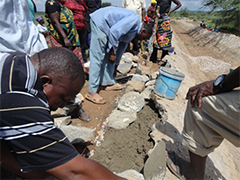Project for Capacity Development for the Promotion of Irrigation Scheme Development under the District Agricultural Development Plans (DADP) Phase 2 (TANCAID2)
| Type | Project | Area | Period | Tanzania Organization |
Cost (Mill. Yen) |
|---|---|---|---|---|---|
| Technical Cooperation Project | Project for Capacity Development for the Promotion of Irrigation Scheme Development under the District Agricultural Development Plans (DADP) Phase 2 (TANCAID2) | Whole country (Mainland) | Aug. 2015 - Aug. 2020 | Ministry of Agriculture (MoA), National Irrigation Commission (NIRC) | 570 |
Irrigation development has been the highest priority in agricultural development of Tanzania under the Agricultural Sector Development Programme (ASDP) phase 1 & 2, MKUKUTA I & II, and Kilimo Kwanza initiative. The National Irrigation Master Plan (NIMP), which was developed in 2002, in collaboration with JICA, identified areas of 29,400,000 ha as potential irrigation areas; however, only 461,326 ha were provided with improved irrigation infrastructure (2014).
To redress the situation, JICA commenced a new technical cooperation project; "Formulation and training on Guideline for irrigation Scheme Development", which was afterwards called "Pre-TANCAID" (2007-2010, TANCAID stands for TANzania CApacity-building for Irrigation Development). This project was succeeded by TANCAID1 (2010-2014) and then by TANCAID2 (2015-2020).

Participatory repair work of an irrigation canal. Irrigators’ Organization (IO) farmers implemented capping works technically supported by district and zone irrigation engineers.
A series of these projects aims at establishing and disseminating an effective technical guideline covering the whole lifecycle of irrigation development, namely, from formulation (planning and design), implementation (construction), to operation and maintenance (O&M). This guideline is called the "Comprehensive Guideline for Irrigation Scheme Development" (CGL), and it has now been incorporated in the National Irrigation Act 2013 and requires that every irrigation development project, including even those funded by other donors / development partners, has to follow the process stipulated in the CGL. The enactment of this Act was also supported by the projects. The objective of CGL is to provide a standardized technical foundation of Irrigation development in order to make it more efficient with assured quality. In parallel, the projects have also been capacitating irrigation engineers of the central government (such as those who are working for the National Irrigation Commission (NIRC) of the Ministry of Agriculture (MoA)), irrigation officers at local governments, and also farmers in Irrigators' Organizations (IOs), so that the CGL can be well embedded in all activities related to irrigation development.
In TANCAID2, CGL has been revised four times to accommodate the challenges encountered during the field practices, and many other relevant technical manuals, such as the one for Efficient and Equitable Water Distribution, Construction Supervision, etc., were drafted / revised as well. In parallel, experienced Japanese experts provided NIRC engineers (who are main counterparts of the project) with a variety of training programs, such as the Site Management and Farmer Participatory Repair Work.
Along with that, the project has also been supporting the application and practice of CGL and relevant manuals in 44 irrigation schemes nationwide with on-the-job training programs to NIRC engineers, related local government officers, and farmers in IOs. In addition, monitoring activities were also conducted multiple times to ensure that those activities take roots in each scheme. Those irrigation schemes were developed through JICA's ODA Loan project to the Government of Tanzania, called "Small Scale Irrigation Development Project" (SSIDP), so as to create a synergy between the technical cooperation (TANCAID2) and the financial assistance for physical infrastructure construction works (SSIDP), and thereby making sure that both projects become more efficient and effective.
During the project period of TANCAID2 for five years, a total of approximately 3,000 irrigation engineers and staff, 3,400 local government officers, and 9,300 farmers of IOs, (counted based on the number of participation in the training programmes) were trained and capacitated. Moreover, the Government through MoA and President's Office - Regional Administration and Local Government (PO-RALG) has officially announced that CGL has to be applied in any irrigation development in Tanzania, which is required by the National Irrigation Act. All these efforts and actions are meant to ensure the sustainability of the project.
JICA believes that Tanzania is going to further expand as well as consolidate the technical cornerstone of irrigation development in Tanzania, which has been established through a series of technical cooperation projects supported by JICA.





scroll